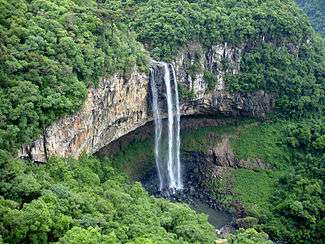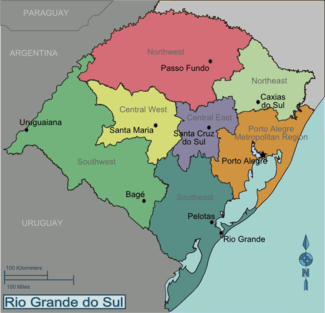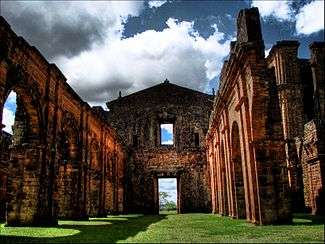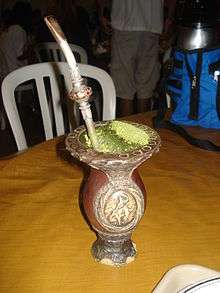Rio Grande do Sul
Rio Grande do Sul is the southernmost state in Brazil, and borders Uruguay and Argentina. It is in some sense a unique region that merges clearly identifiable elements of Brazilian culture, the culture of Pampas region which also includes Uruguay and a large portion of Argentina, as well as the culture of German and Italian immigrants.

Regions

| Central West Famous for paleontological tourism along the "Paleorrota" |
| Central East A major center of gaúcho culture, hosting the state's most important art event in the city of Santa Cruz do Sul |
| Northeast Contains part of the Serras Gaúchas, with a rich Italian heritage, and part of the Aparados da Serra National Park |
| Northwest Contains the Sete Povos das Missões, a collection of Jesuit ruins, one of them a World Heritage Site |
| Grande Porto Alegre The most visited part of the state, containing the capital city Porto Alegre, the popular destinations of Gramado and Canela in the Serras Gaúchas, and the state's most popular beaches |
| Southeast The Patos and Mirim lagoons, the Taim Ecological Station, and very tranquil beaches |
| Southwest The vastness and cultural richness of the Pampas region on all its glory |
Cities

- 🌍 Porto Alegre - The state's capital city and headquarters to the World Social Forum
- 🌍 Bento Gonçalves - Charming city with Italian heritage, with many vineyards and exuberant food culture. Brazilian capital of grapes and wine.
- 🌍 Canela - Often visited as a side-trip from Gramado but with enough attractions to visit on its own, it's a great area for ecotourism
- 🌍 Caxias do Sul - Rich Italian heritage and traditional wineries in the rural region
- 🌍 Gramado - With cool weather, a picturesque city center and lots of family activities, it's where Brazilians go to feel like they are in Europe
- 🌍 Santa Cruz do Sul - City of the ENART, the most important art festival of the state, and of Rio Grande do Sul's Oktoberfest
- 🌍 Uruguaiana - Where Brazil and Argentina meet and mix with each other
- 🌍 São Miguel das Missões - Containing the Ruins of São Miguel das Missões, a UNESCO World Heritage Site
- 🌍 Torres - With beaches surrounded by impressive cliffs
Understand
People born in Rio Grande do Sul are called gaúchos. The state has a unique history that sets it somewhat apart from the rest of the country. It was initially settled by Spanish Jesuits in the 17th century, which founded there seven Jesuit missions, the Sete Povos das Missões. The region would become subject of violent disputes between Spanish and Portuguese settlers, often using local indigenous tribes as proxies. While the Spanish eventually were expelled, they left strong marks in the Rio Grande do Sul's culture, culinary and language, renewed by the continuous interaction between the region and its Spanish-speaking neighbouring colonies (which would eventually become the countries of Argentina and Uruguay).
Rio Grande do Sul is the only Brazilian state which managed to obtain de-facto independence for some period of time. A few years after Uruguay became independent from Brazil, the state, during the 1835-1845 Ragamuffin War (Guerra dos Farrapos), rebelled against Brazil's Imperial government, and formed the Riograndense Republic, which existed for 9 years. Although it was defeated, the revolution and its commanders such as Bento Gonçalves and Garibaldi remain a strong source of pride and of regional identity for gaúchos, as well a source of inspiration for Brazil's South Region timid separatist movement.
After the Guerra dos Farrapos and until the beginning of the Second World War, the state received a large number of immigrants, especially from Germany and Italy, to settle in the state's rural areas. The cultural impact of those immigrants remains strongly felt, especially in the northern half of the state, with some towns still speaking dialects of German and Italian, and interestingly, has contributed to strengthen, rather than dilute, the gaúcho unique regional identity.
Attractions
Rio Grande do Sul gets much less foreign visitors than its beach-famous neighbouring state Santa Catarina. However, its mountainous region of Serra Gaúcha north of the capital Porto Alegre, which contains the municipalities of Antônio Prado, Gramado and Canela, is very popular among Brazilian tourists, due to its cool weather, beautiful nature, legacy of German and Italian immigrants, and excellent wineries.
Outside the Serra Gaúchas, tourist infrastructure is limited, and it might be more difficult to enjoy what the region has to offer without speaking Portuguese or Spanish, or at least without having a local guide. It is, however, certainly worth visiting for those interested in the proud and unique gaúcho culture, including traditional dances and arguably the best BBQ meat (churrascos) of Brazil. South and west of the capital, a vast portion of the state is covered by the Pampas Gaúcho, a mostly rural area with culture more close to the neighbouring countries of Argentina and Uruguay, famous for the high-quality cattle production. A good point to get to better know the culture of the region is the city of Bagé, near the border of Uruguay, which hosts several gaúcho events such as the Festa Internacional do Churrasco.
The coast of the state is entirely lined up with sand beaches, but the state is not a famous beach destination. Only the city of Torres gets some fame from its beaches, due to its beautiful basalt cliffs. Finally, the capital Porto Alegre is also not a popular tourist destination, although it's a large, bustling metropolis, and there are plans to renew the city's under-utilised wharf and turn it into a lively promenade.
Talk
Natives of the state typically speak the gaúcho Portuguese dialect, strongly influenced by the Spanish of the Pampas region. The dialect is notably different from standard Brazilian Portuguese and has many unique words and expressions, but gaúchos will generally switch to a more regular Brazilian Portuguese when talking to Brazilians of other regions.
In the border areas with Argentina and Uruguay, the portunhol, i.e. a mix between Brazilian Portuguese and Spanish, is commonly used as "bridge language" between Brazilians and their Spanish-speaking neighbours.
Local dialects of German (Riograndenser Hunsrückisch) and Venetian (Talian) are spoken by some communities of German and Italian descendants in Rio Grande do Sul, although one needs to go to smaller towns and rural communities to ever hear them, for instance Nova Petrópolis or Serafina Corrêa.
Get in
By plane
The best way to get to Rio Grande do Sul is to fly to Porto Alegre (Salgado Filho Airoport) from São Paulo or Rio where most international flights to Brazil arrive.
From Porto Alegre you can get anywhere else in Rio Grande do Sul by rental car, or by taking a guided tour. From Salagado Filho Airport you can take the Trensurb tram to the city center of Porto Alegre or get off in the Rodoviaria Station (Coach station) from which you can continue to many other destinations - the buses are pretty safe and comfortable.
By car
Rio Grande do Sul can be easily accessed by land from several roads coming from Argentina and Uruguay. Depending on the checkpoint, visitors may have to pass through two segregated immigration facilities (one to emigrate and another to immigrate), or they may be co-located. The state has two cities, Santana do Livramento and Chuí, which are in full conurbation with the respective cities of Rivera and Chuy in Uruguay. In these cities, as well as others on the Brazil/Uruguay border, people can freely cross the border between the countries as long as they remain in the conurbation, but are still required to pass through regular emigration/immigration formalities in order to venture any beyond that. For example, a visitor with legal permission to stay in Uruguay who is in Rivera can walk to Santana do Livramento and move freely there, but visitors who want to go to any other place in Brazil must pass through emigration/immigration formalities.
By bus
Buses are available from Uruguay, Paraguay, Argentina, and other parts of Brazil. Porto Alegre is the big transportation hub.
As when you travel by car, if you are going from Uruguay to Brazil or vice versa, make sure to pass through the emigration/immigration checkpoints in both sides of the border. If you're taking a direct bus from Uruguay to Brazil, the bus company should take your passport and do the border formalities for you while you stay on the bus; if there are any issues they'll wake you up so you can address them. If you're taking a bus to a border town and then crossing the border and taking another bus from the other side, it's your responsibility to make sure you go to passport control. The bus driver should stop there for you if you ask.
Get around
The state is well connected by bus. Porto Alegre is the largest hub of road transportation, with a long-distance bus terminal (Estação Rodoviária de Porto Alegre, in portuguese, Porto Alegre Bus Station) that serves several cities in the interior of the state. The cities of Porto Alegre, Canoas, Esteio, Sapucaia do Sul, São Leopoldo and Novo Hamburgo, in the region of Grande Porto Alegre, also have a surface subway line known by the local habitants as Trensurb (abbreviation in Portuguese for "Urban Trains").
Eat
For many Brazilians, Rio Grande do Sul is synonymous with churrasco, the Pampas-style barbecued beef, and as the state is a large producer of cattle, it is easy to be spoilt in terms of options of barbecued meat restaurants. The state was the place of foundation of the Fogo de Chão Brazilian restaurant chain, although the chain has far more branches in the United States than in Brazil, and no branches at all in Rio Grande do Sul. Every year, the city of Bagé hosts a festival dedicated to churrasco, along with typical gaúcho music and dance.
Other famous gaúcho dishes are the charque (dried salted beef), the arroz carreteiro (a sort of risotto based on charque) and the galeto ao primo canto (grilled spring chicken).
Drink
.jpg)
Rio Grande do Sul's trademark beer is the Serramalte, known for its strong malt flavour and bitter taste, and commercialised by the Ambev conglomerate. The state is also known for its variety of craft beers and for producing the best wines of the country - according to the Il Sommelier magazine, no less than 13 of Brazil's 16 best wines are from Rio Grande do Sul. Most of these wines are produced in the Italian-settled area of the Serras Gaúchas, in particular, the triangle formed by Bento Gonçalves, Pinta Bandeira and Garibaldi. Not surprisingly, this area should be the starting point for enotourism enthusiasts.

Chimarrão, also known as mate, is a hot beverage made from yerba mate leaves and drunk through a metal straw, distinctive to Rio Grande do Sul and neighboring areas such as Uruguay, Argentina, and to a lesser extent Santa Catarina. You'll see the distinctive chimarrão gourds everywhere, and unlike in Uruguay and Argentina, here they range in size from small ones that only hold a couple of gulps to very large ones that you could sip for a while.
Go next
- Santa Catarina, the state north of Rio Grande do Sul, with popular beaches and German- and Italian-influenced culture
- Uruguay has a lot in common with Rio Grande do Sul, including gaucho culture and mate (their version of chimarrão)
- Misiones, Argentina, with ruins of missions and half of Iguaçu Falls (the other half is in the state of Paraná, Brazil)